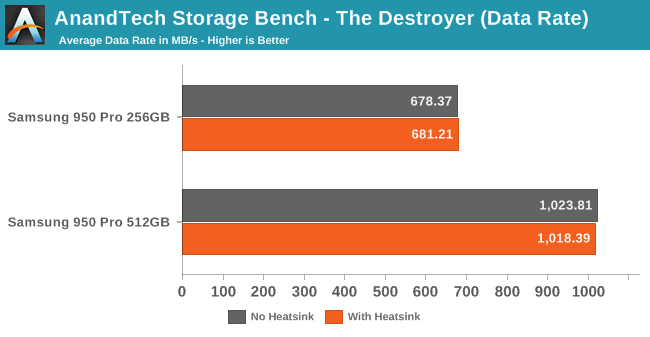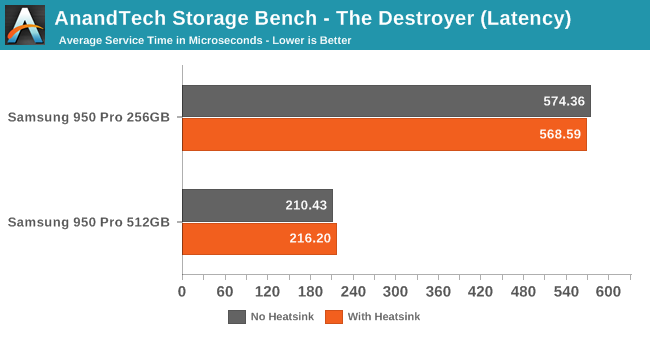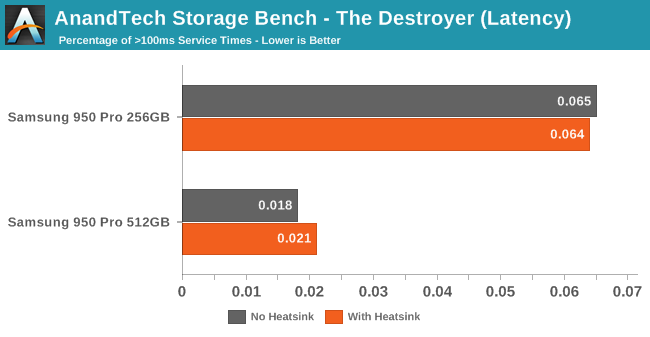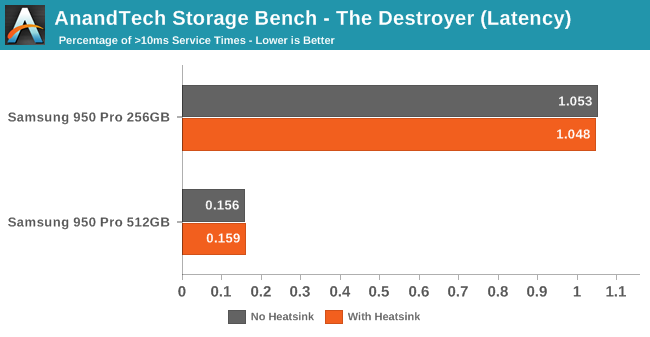The Angelbird Wings PX1 M.2 Adapter Review: Do M.2 SSDs Need Heatsinks?
by Billy Tallis on December 21, 2015 8:00 AM ESTAnandTech Storage Bench - The Destroyer
The Destroyer is an extremely long test replicating the access patterns of heavy desktop usage. A detailed breakdown can be found in this review. Like real-world usage and unlike our Iometer tests, the drives do get the occasional break that allows for some background garbage collection and flushing caches, but those idle times are limited to 25ms so that it doesn't take all week to run the test. Those pauses of up to 25ms are sufficient for the drive to complete a reasonable amount of background processing and return to idle, but they don't give the drive much time to cool off.


Average data rate on The Destroyer was essentially unchanged by the addition of the heatsink. The difference measured for average service time was slightly higher, but still insignificant. In both cases, the heatsink helped the 256GB drive and hurt the 512GB drive.


The frequency of latency outliers was also subject to some variation between runs, but its hard to attribute it to the influence of the heatsink since the effect was in the opposite direction for the two drives. With or without the heatsink the 950 Pro is posting great scores, and the 512GB drive outperforms the 256GB drive by a wide margin.










69 Comments
View All Comments
edzieba - Tuesday, December 22, 2015 - link
With most Skylake ITX boards having the m.2 slot on the back, it would be interesting to see how well a simple coupling of the drive to the motherboard backplate with an adhesive thermal pad compares to the bare drive (and/or to a dedicated PCIe slot heatsink like this). I suspect the relatively tiny power levels involved (barely over 5W at most) would mean a nice sheet of aluminium or steel would be more than enough heatsinking for even sustained heavy loads.zodiacfml - Tuesday, December 22, 2015 - link
Performance of these drives are awesome that I would never be able to throttle them even if I try. Regarding the form factor, I believe they have designed it really well. It might be too big in 5 to years from now.fvbounty - Tuesday, December 22, 2015 - link
Can you post some temps, I'm surprised you didn't have them in the review?kilgor270 - Friday, January 1, 2016 - link
Just installed my PX1 with a Samsung SM951 as my boot drive. The PX1 seems to be very well constructed in my opinion. Easy to put the SM951 chip in and then install into computer.The white LED's were a surprise. Since I'm not a gamer, to me the leds are just an indication that power is going to the board. I monitored the heat using a couple software apps and at first glance without stressing it, it is hovering around 90 degrees F. Performance r/w is right around 1450 MBs +/-Overall for a couple days testing, I am very very happy with this combination as a boot drive. Totally changed my overall system profile in a very positive way.
orencom - Thursday, January 7, 2016 - link
the real question is weather there are real use cases which utilize PCIe SSD bandwidth capabilities...Machou360 - Sunday, January 10, 2016 - link
Just bought two of these and in RAID0, they are a beast ! Made the same bentches and putting a raspberry heatsink on each of the M2 controller simply avoids any heat issue (had to remote part of the sticker for that, which was very easy) I would recommend these drives anytime, performance is superb!XmppTextingBloodsport - Saturday, March 19, 2016 - link
"Will thrashing air about be efficacious?""Should we really rely upon [haphazard] fans for cooling?"
jefflynn333 - Sunday, September 4, 2016 - link
I would like to see the Angelbird tested against just using small heat sinks attached to the 950. That seems like a logical alternative.